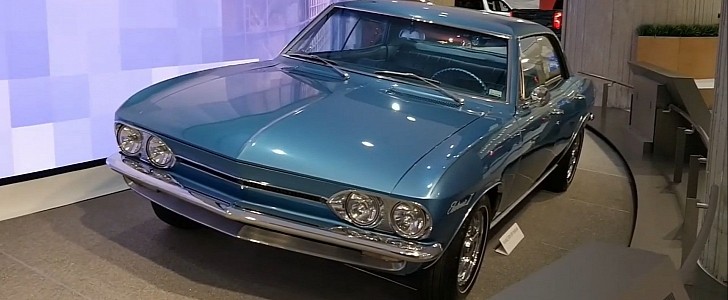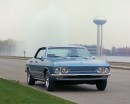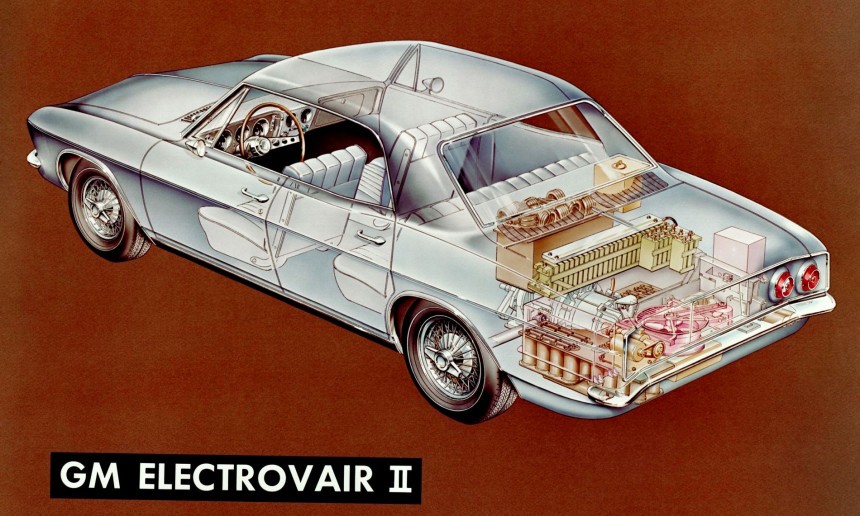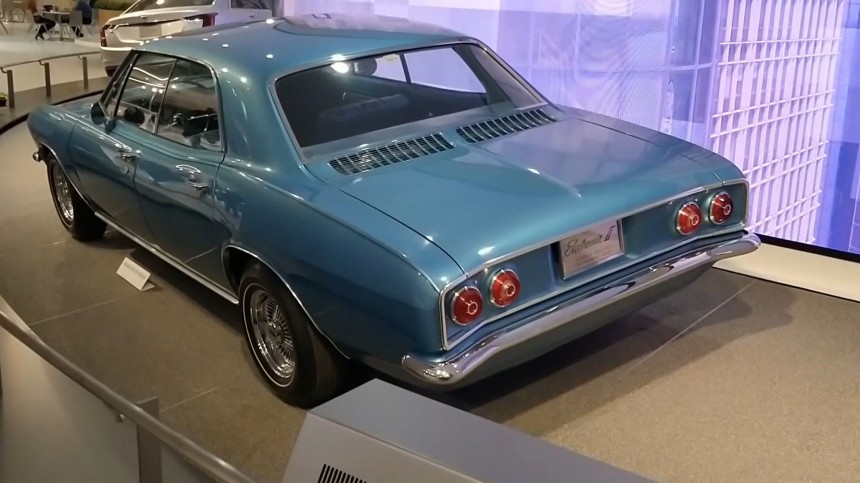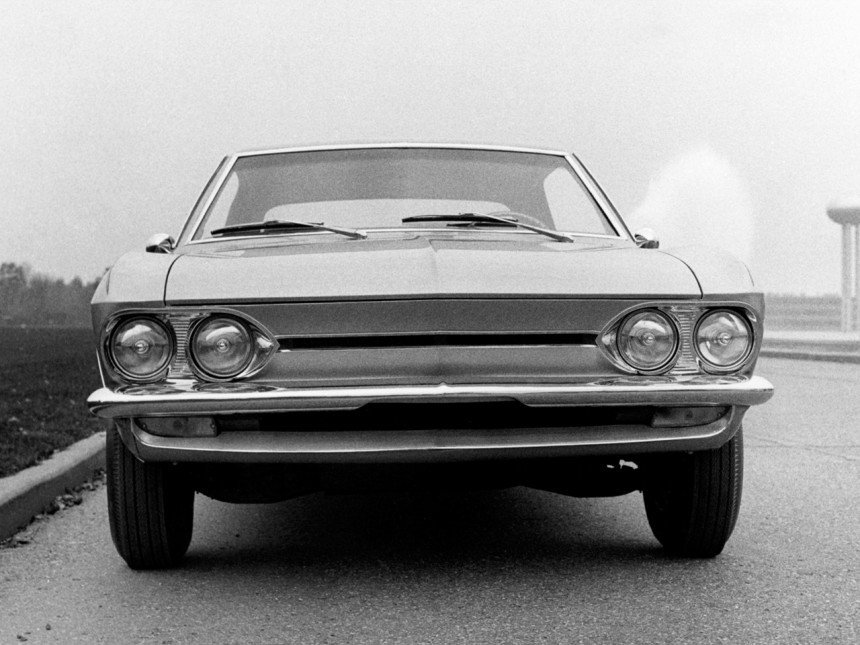Chevrolet didn't offer an all-electric production car until the Bolt arrived in 2016. Before that, Chevy rolled out the Volt plug-in hybrid, which debuted for the 2011 model year. But Chevrolet began experimenting with electric cars as early as the 1960s. Meet the Electrovair, the battery-powered Corvair you never knew existed.
The story of the Electrovair began in 1964 when GM built the first Corvair fitted with an electric motor and a battery pack instead of a flat-six engine. There's not a lot of info on this prototype based on the first-gen Corvair, but Chevrolet revisited the idea in 1966.
By that time, it had introduced the second-gen compact with a new suspension design to correct the notorious handling problems of the first Corvair.
Apparently, GM picked the Corvair for its electrification project for two reasons. First, it was the lightest car in its corporate lineup at around 2,500 pounds (1,134 kg). Second, the Corvair was a rear-engined car, making it the perfect candidate to receive an induction motor in the rear and a battery pack in the rather spacious front trunk.
But Chevrolet also had loads of Corvairs sitting around as sales plummeted following the publication of Ralph Nader's book, "Unsafe at Any Speed," in 1965.
The Electrovair II, based on a 1966 Monza four-door hardtop model, looked identical to a regular Corvair inside and out. But the 2.7-liter flat-six mill was no longer filling up the space atop the rear axle, having been swapped out for an AC induction motor.
The unit was good for 115 horsepower. For reference, the gas-powered 1966 Corvair delivered 95 horses in the base spec and 140 horsepower in range-topping trim.
The motor got its juice from a 532-volt silver-oxide battery pack mounted under the front hood, which acted as a trunk on the regular Corvair. The conversion added almost 1,000 pounds (454 kg) to the car's curb weight, which made the Corvair as heavy as a full-size Chevrolet Impala.
But that's still lighter than a modern Tesla Model S, which tips the scales at more than 4,300 pounds (1,950 kg).
GM claimed that the electrified Corvair needed around 16 seconds to hit 60 mph (97 kph) from a standing start. It seems painfully slow at first glance, but the EV was actually on par with the base Corvair. It was, however, some four seconds slower than the 140-horsepower sedan.
The drivetrain topped out at 80 mph (129 kph), notably slower than the regular production Corvair, good for 93 to 108 mph (150 to 174 kph) depending on engine specs.
Range, on the other hand, was very limited since batteries were far from compact at the time and the Corvair's trunk had its space limitations. GM advertised the Electrovair's range at 40 to 80 miles (64 to 129 km) on a full charge.
But the almost unusable range wasn't the concept car's only problem. The high-density silver-oxide batteries were not only expensive and still heavy at the time, but they also wore out after being recharged only 100 times.
So they had to be replaced after the Electrovair covered 4,000 to 8,000 miles (6,437 to 12,875 km), a little more than a trip from New York to Los Angeles and back.
But GM never planned to turn the electrified Corvair into a production model, so the company was happy with the attention it got from showcasing the EV to astonished journalists.
While some viewed the Electrovair as a preview of things to come, little did they know that the electric car was still a few good decades away.
As the early 1970s brought the first regulations for fuel economy and emissions, automakers began focusing on new technologies for gasoline engines. GM's next venture into electric cars would only come in the late 1980s when the development of the iconic EV1 began.
Chevrolet also built an electric concept based on the Chevette hatchback in 1978. It was named the Electrovette and was capable of traveling up to 50 miles at 30 mph (80 km at 48 kph), and had a top speed of 53 mph (85 kph).
Finished in light metallic blue, the Electrovair II has been kept and maintained to this day and it can be viewed on display inside GM's Renaissance Center in Detroit.
By that time, it had introduced the second-gen compact with a new suspension design to correct the notorious handling problems of the first Corvair.
Apparently, GM picked the Corvair for its electrification project for two reasons. First, it was the lightest car in its corporate lineup at around 2,500 pounds (1,134 kg). Second, the Corvair was a rear-engined car, making it the perfect candidate to receive an induction motor in the rear and a battery pack in the rather spacious front trunk.
The Electrovair II, based on a 1966 Monza four-door hardtop model, looked identical to a regular Corvair inside and out. But the 2.7-liter flat-six mill was no longer filling up the space atop the rear axle, having been swapped out for an AC induction motor.
The unit was good for 115 horsepower. For reference, the gas-powered 1966 Corvair delivered 95 horses in the base spec and 140 horsepower in range-topping trim.
The motor got its juice from a 532-volt silver-oxide battery pack mounted under the front hood, which acted as a trunk on the regular Corvair. The conversion added almost 1,000 pounds (454 kg) to the car's curb weight, which made the Corvair as heavy as a full-size Chevrolet Impala.
GM claimed that the electrified Corvair needed around 16 seconds to hit 60 mph (97 kph) from a standing start. It seems painfully slow at first glance, but the EV was actually on par with the base Corvair. It was, however, some four seconds slower than the 140-horsepower sedan.
The drivetrain topped out at 80 mph (129 kph), notably slower than the regular production Corvair, good for 93 to 108 mph (150 to 174 kph) depending on engine specs.
Range, on the other hand, was very limited since batteries were far from compact at the time and the Corvair's trunk had its space limitations. GM advertised the Electrovair's range at 40 to 80 miles (64 to 129 km) on a full charge.
So they had to be replaced after the Electrovair covered 4,000 to 8,000 miles (6,437 to 12,875 km), a little more than a trip from New York to Los Angeles and back.
But GM never planned to turn the electrified Corvair into a production model, so the company was happy with the attention it got from showcasing the EV to astonished journalists.
While some viewed the Electrovair as a preview of things to come, little did they know that the electric car was still a few good decades away.
Chevrolet also built an electric concept based on the Chevette hatchback in 1978. It was named the Electrovette and was capable of traveling up to 50 miles at 30 mph (80 km at 48 kph), and had a top speed of 53 mph (85 kph).
Finished in light metallic blue, the Electrovair II has been kept and maintained to this day and it can be viewed on display inside GM's Renaissance Center in Detroit.
